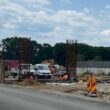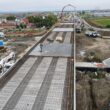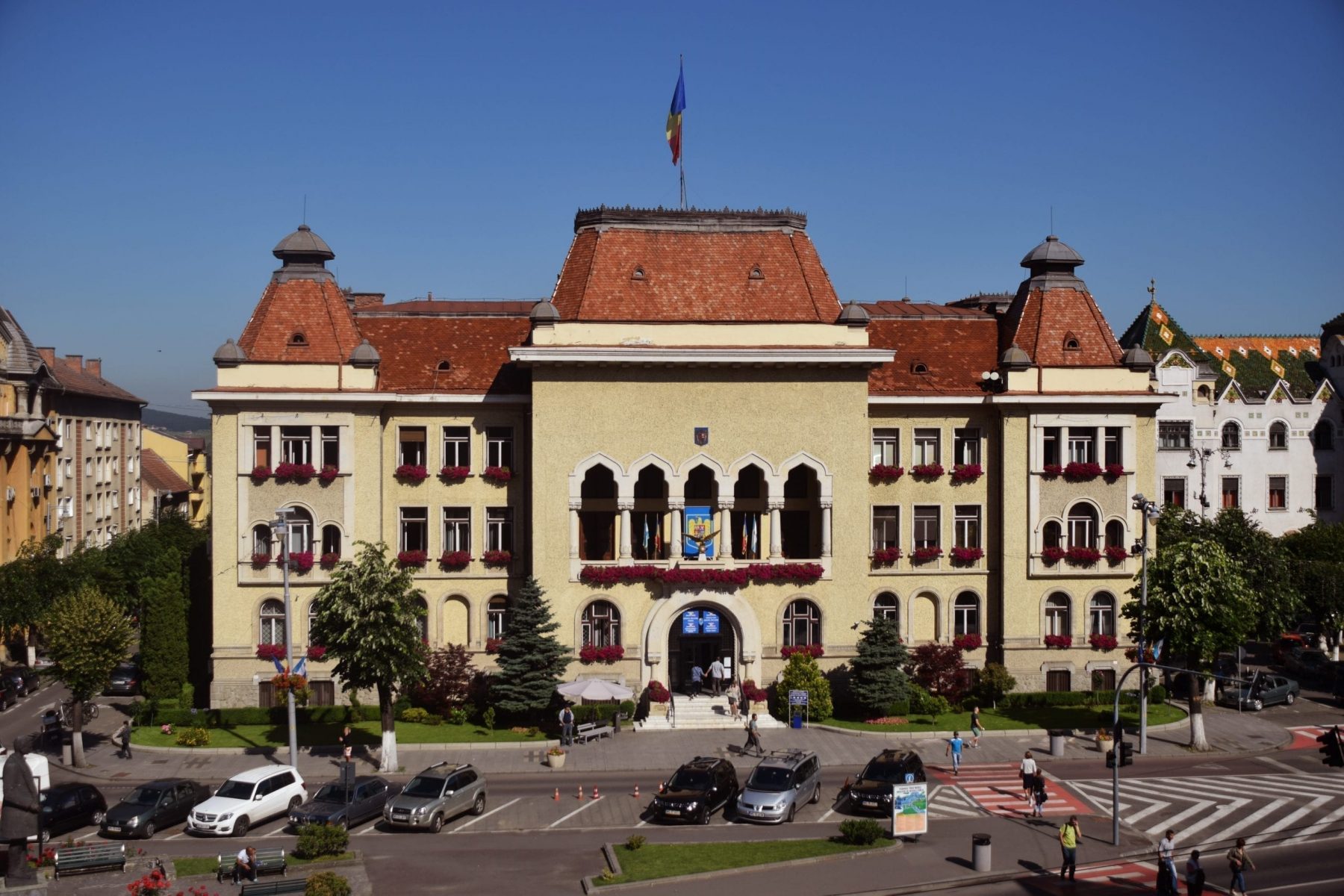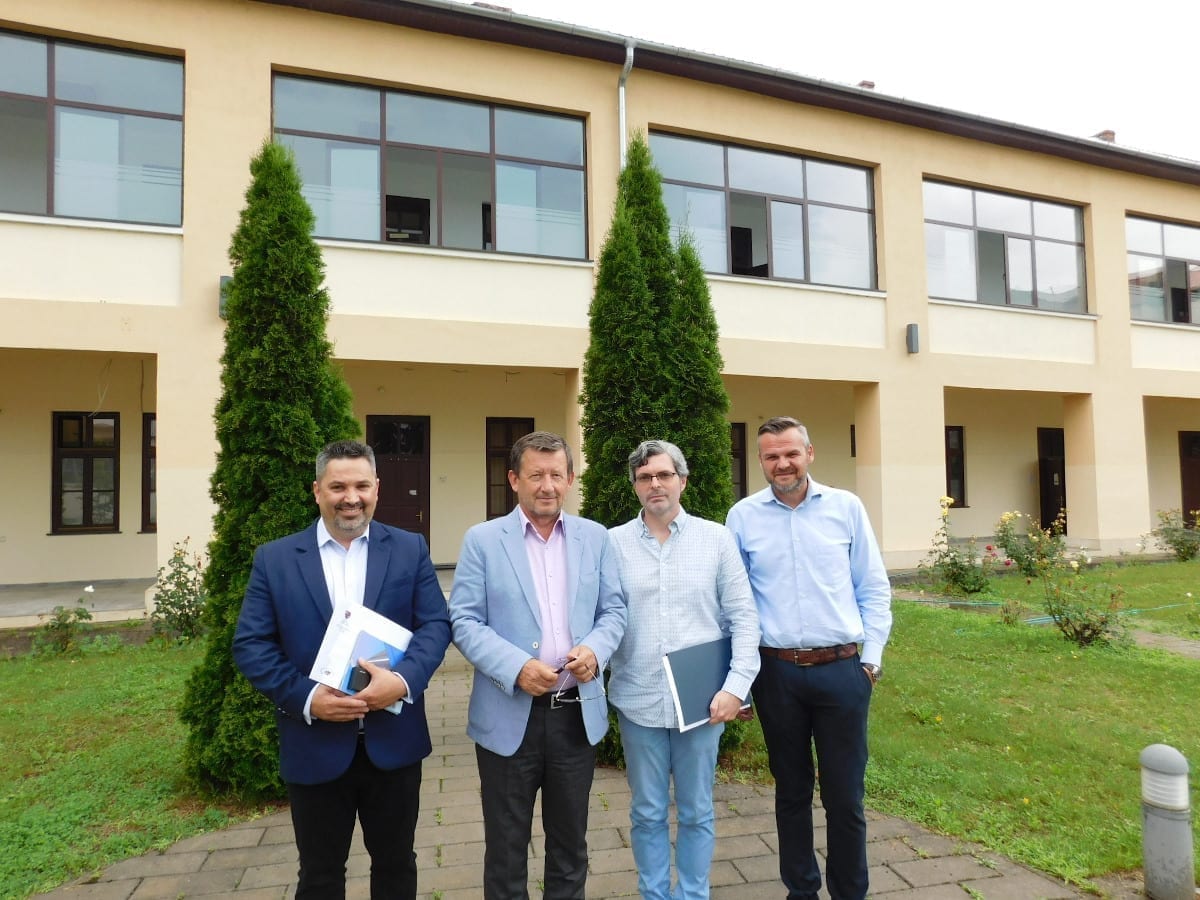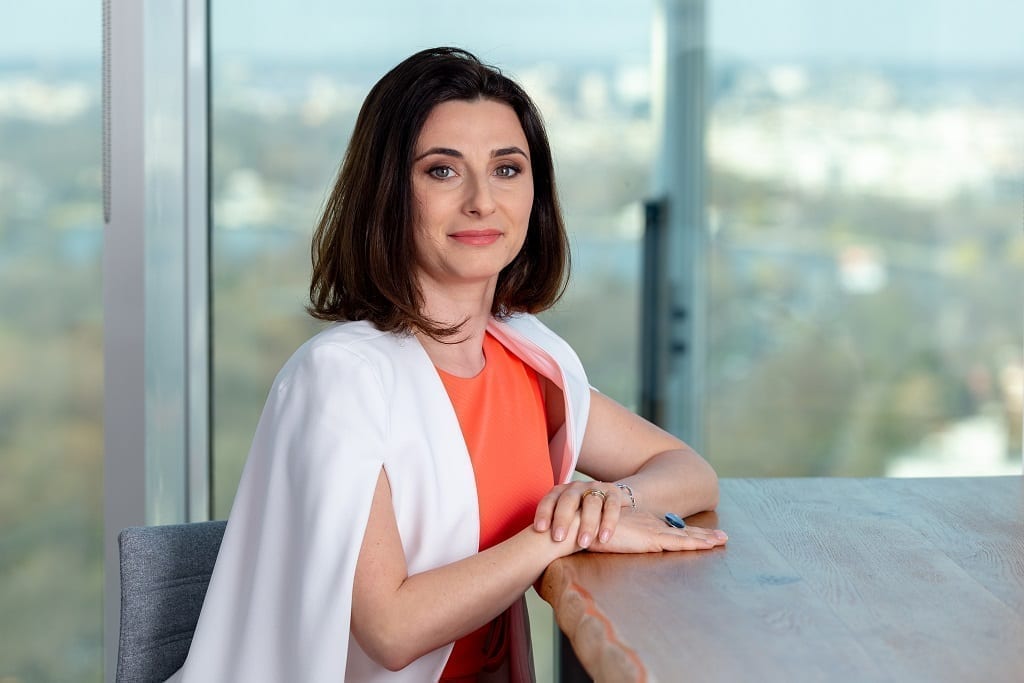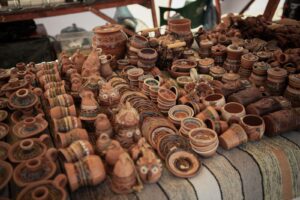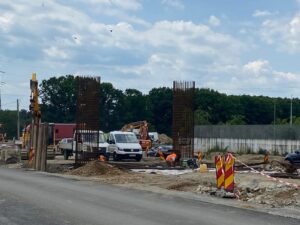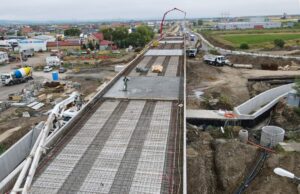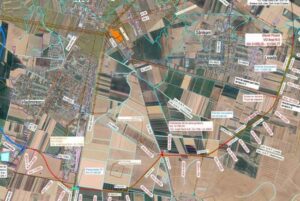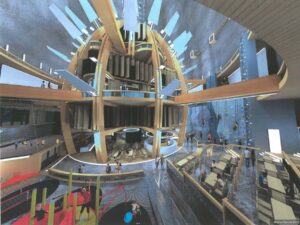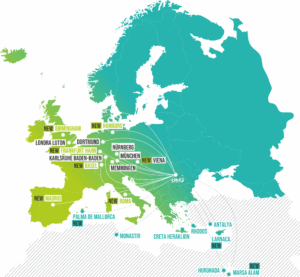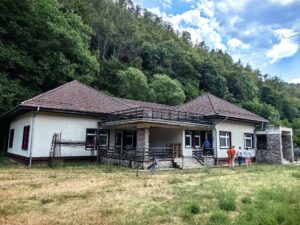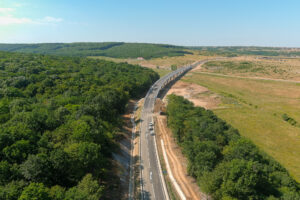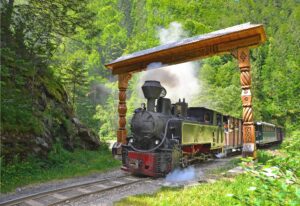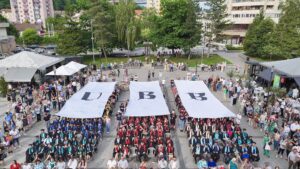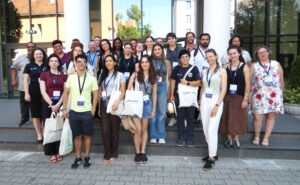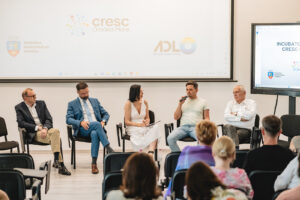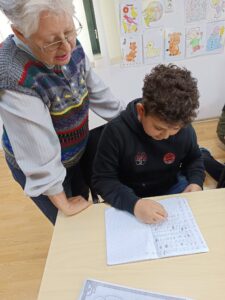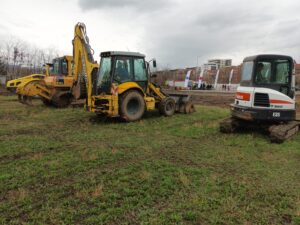Târgu Mureș detaines an various architectural patrimony, and tourists can enjoy visiting monuments from Medieval, Renaissance, Baroque or Art Nouveau era. They can discover the intrigued history of these beautiful buildings on TGM Tour App, developed by Crug for Târgu Mures City Hall. The tourism application can be downloaded from Google Play or App Store.
City Hall (former County Hall)
You are now in front of the most important landmark in the Neo-Romanian style in Târgu Mureș. It currently serves as the City Hall, although it originally had a different role, as the building was erected to replace the former county hall, which no longer met the standards required of it at the time.
By the beginning of the 20th century, it had become increasingly clear that the county hall needed a new headquarters. The building in which the institution’s activities took place was in an alarming state of degradation, and the quality of the area it was located in, gone downhill.
A new county hall needed to be built, and the first step taken was to organise a competition for the project. The winning proposal was put forward by Komor Marcell and Jakab Dezső. The two architects, renowned specialists in the Secession style, were familiar with Tîrgu Mureș, having been responsible for two of the city’s landmark buildings just a few years earlier: the Palace of Culture and the Administrative Palace. However, the plans were put on hold because of the outbreak of the First World War.
At the end of the war, with Transylvania now having become part of Romania, discussions began once again. The need for a new county hall was just as great as it had been before, but there was one new requirement. The building had to be constructed in a style that was indigenous to Romania.
At the beginning of 1935, a competition was once again organised. This time the winner was a Bucharest-based architect, Eugen Grosu. The fact that he was chosen over a local architect should not come as a surprise. While Transylvania by no means lacked major architects, their preferred style was Secession. For the construction of a building in a recognisably Romanian style, the real specialists were to be found in the capital.
Work began in 1936, and six years later, in 1942, the new county hall was finished. Besides the city centre’s two monumental Secession buildings, Tîrgu Mureș now had an imposing structure in the Neo-Romanian style.
The building is composed of three sections, forming a U-shape. The largest is the central section, which has a symmetrical facade, the entrance being located on its central axis. Above the entrance you can see the loggia of the Hall of Honour, which is situated on the first floor. The loggia opens up to the outside through a row of arcades with six supporting columns. If you look closely at any of the arcades, you will observe it has a very special shape, that makes reference to Oriental Architecture. This is one of the most common features of the Neo-Romanian style.
However, Tîrgu Mureș in the 20th century, was a place with an unpredictable history, and the building was used for its originally intended purpose only for a short time. Not long into the period of communist rule, in 1950, the County Hall stopped functioning here, as it needed to house the headquarters of the People’s Council. A few years later, in 1968, its fortunes changed once again. The People’s Council was moved to the Administrative Palace, the current county hall, and in its place the City Hall was moved here. Since then, the Municipal City Hall has been housed in Tîrgu Mureș’s most beautiful building in the Neo-Romanian style.
Medieval Citadel
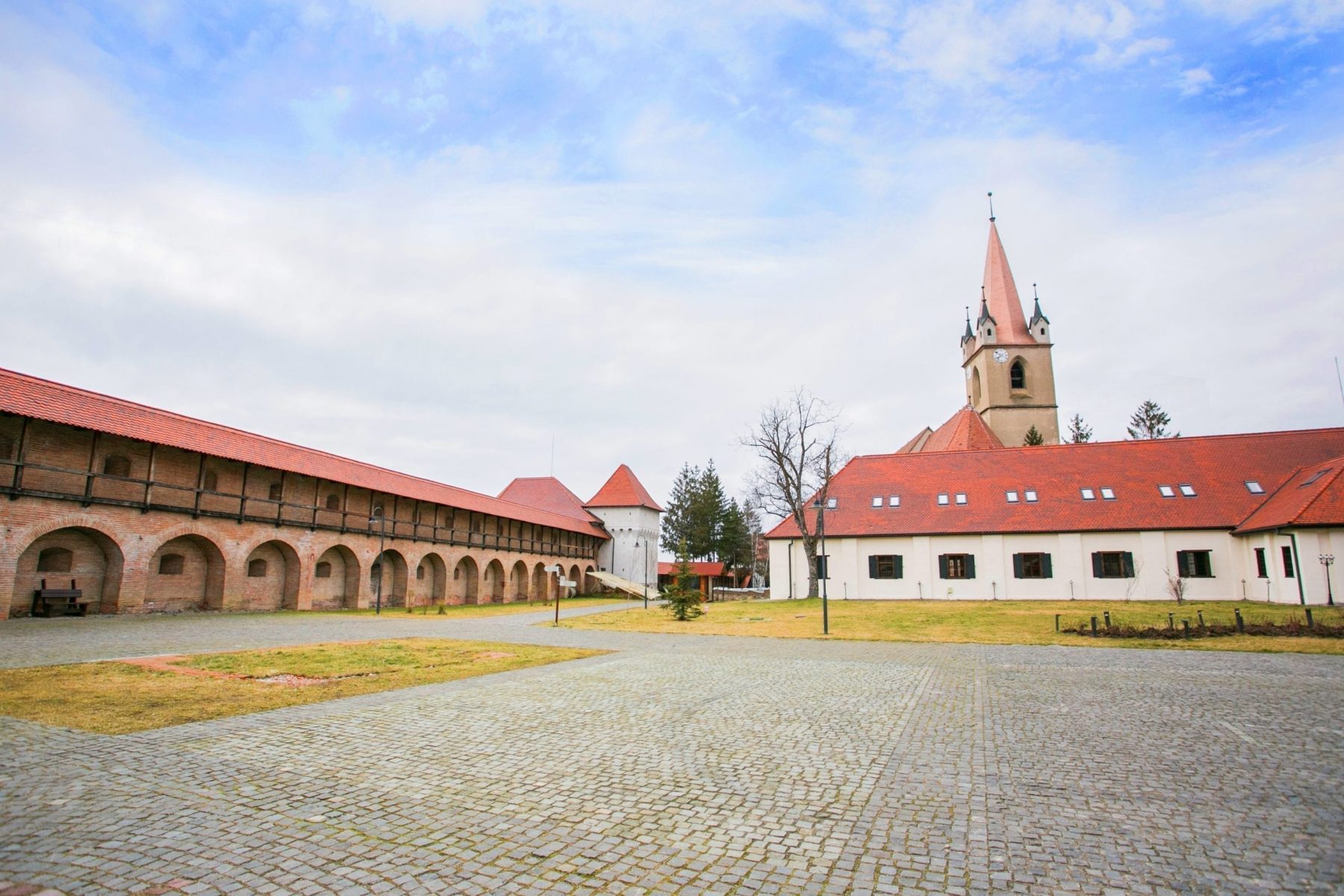
The story of Tîrgu Mureș’s medieval fortress begins in the 15th century. At the time, surrounding the Reformed Church that you can now see, was the Franciscan Monastery complex. It was the biggest monastery of this type in Transylvania, and it was significant not just for the local population, but also on a regional level. Feeling the need to assure the monks and parishioners of a degree of security, the authorities decided to build stone fortifications around the monastery, and work on this was completed in 1492.
The area enclosed within the walls was much smaller than that which you can now see, and the walls left a lot to be desired in their ability to withstand attacks. This had severe consequences in 1601, when the town was attacked and easily overrun by the troops of the Habsburg general, Giorgio Basta. There were more problems to follow a year later, when the fragile walls were of little help to locals defending themselves from the 400 mercenaries enlisted by Moses Székely.
After these incidents, the need for sturdier fortifications had become obvious, as building a new defensive system was now a matter of life and death. The inhabitants of the town contributed with money, as well as with unpaid labour. Five of the seven bastions of the citadel were built by five of the town’s wealthiest guilds: the tailors, the coopers, the furriers, the boot-makers and the butchers. Members of each of these associations of craftsmen were obliged to maintain the bastions they were responsible for, and to defend them in case of an attack. This explains why each of the five bastions still bear the names of the guilds that took care of them.
The different shapes and sizes of the bastions demonstrate that the citadel wasn’t built according to a unified plan. Despite this, those building it knew very well what features they needed to have, and two of these can easily be observed. Firstly, all of the bastions were built to accommodate the latest firearms. The lower levels are fitted with holes for cannons, while the facades of the upper levels contain openings for lighter-gauge weapons. Secondly, the citadel was built entirely of brick, which is more durable than stone, and better able to withstand attacks from firearms outside.
Once the citadel was complete, Tîrgu Mureș could be said to be made up of two separate towns: one within the defensive walls, and another outside. Wanting to ensure safety for their family and their property, townspeople were far more interested in buying houses within the citadel. In order to avoid speculative property buying, a law was enacted stipulating that any citizen could only own one house inside the walls.
In the 18th century, with Transylvania now part of the Habsburg Empire, the citadel was taken over by Austrian troops. The townspeople living inside the walls were evicted, some residences demolished, and those that remained were transformed and adapted to the needs of the army. In time, new constructions appeared. These included a barracks close to the entrance, as well as a storehouse for cereals used for military supplies.
The citadel stayed in the possession of the Austrian army for two centuries, until the First World War. In the years that followed, it was still used for military purposes, the fortifications and the buildings inside, now in the possession of the Romanian Army. In 1984, the Citadel came into the care of the local administration.
Nowadays, following a thorough restoration process, the former medieval fortress has become one of the most visited points of interest in Tîrgu Mureș. As well as being a must-see for those visiting the city, for many locals it’s the perfect place to unwind.
Once inside, visitors can visit the Tîrgu Mureș Museum of history and Archaeology. Here you can find some of the most valuable items that have been discovered by researchers inside the walls of the Citadel. These include artefacts from a workshop that made bronze goods in the 15th century, and objects used in the brick factory that was located here in the 16th and 17th centuries.
According to some specialists, this may in fact be the first building of an industrial nature in Romania.
Wooden Church (Eminescu’s Church)
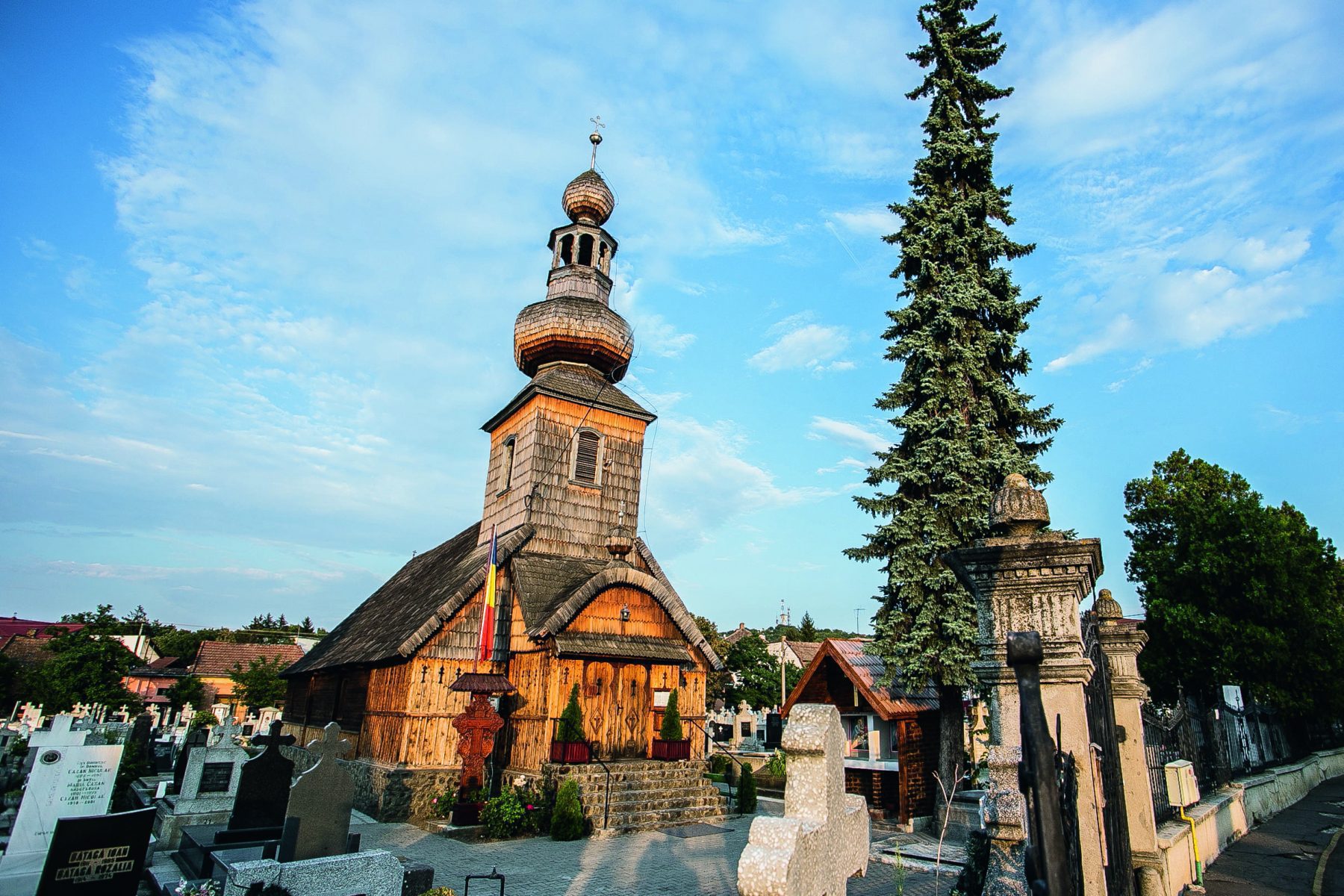
Around 1790, Tîrgu Mureș didn’t have an Orthodox church. In order to attend religious services, the faithful had to go to Sîncrai, a village on the other side of the river Mureș. However, this situation was resolved with the construction of the church on Andrei Șaguna Street. It’s official name is the Church of St. Michael the Archangel, but the locals know it by a more familiar one: The Wooden Church.
Its construction, which was completed in 1794, lasted two years, while the murals inside it were finished two decades later. An inscription to the right of the altar bears the names of the founders of the church, the names of the painters, and the date the paintings were completed: 1814.
The main donor of funds for this place of worship was a Greek trader called Stoian Hagi Costandin. The fact that it was a Greek and not a Romanian who put forward the biggest contribution to the first Orthodox church wasn’t by chance. In the 18th century, a large number of Greeks settled in Tîrgu Mureș. Thanks to their affinity for commerce, many of them had managed to amass large fortunes. Profoundly Orthodox and with considerable resources at their disposal, it wasn’t uncommon for them to donate some of their money to churches that would follow Byzantine rites.
The beams of the building are arranged in a shape that resembles a swallow’s tail. This was one of the most widespread construction methods for Romanian churches in Transylvania. However, to say that the building is a traditional structure wouldn’t be fully accurate, as there’s one detail that’s clearly in the baroque style, which was prevalent at the time. Specifically, this is the tower, with its roof in the shape of a bulb.
At the time when this place of worship was raised, the town’s other churches were the Reformed Church in the Citadel, the Roman Catholic Church in the centre, the Franciscan Church and the neighbouring Stone Church. This means that from an aesthetic point of view, there was serious competition. We’ll leave it to you to decide how well the church founded by Hagi Stoian bears up to the competition.
Synagogue (Great Temple)
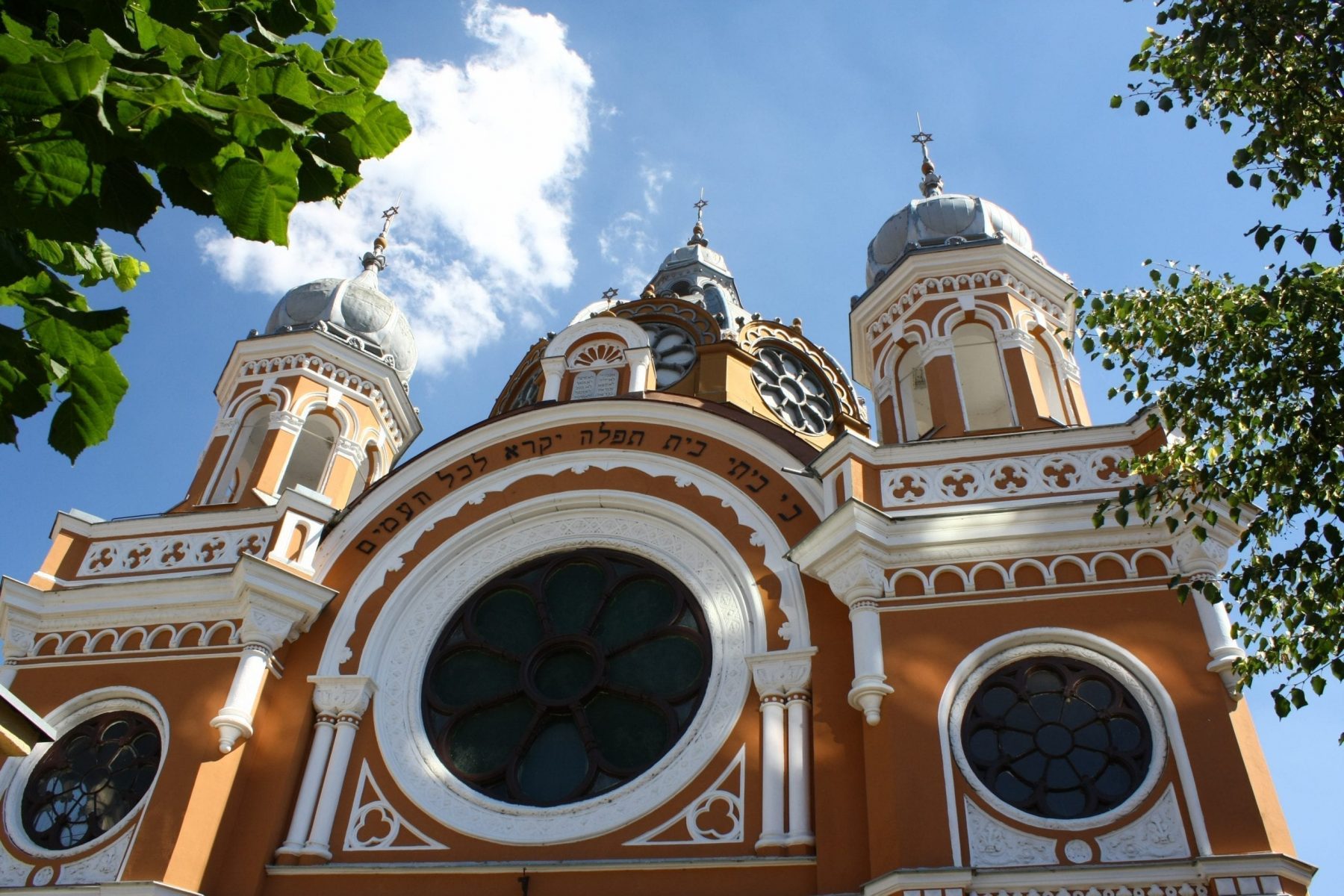
At the end of the 19th century, the Jewish community of Tîrgu Mureș accounted for almost ten per cent of the population. From a doctrinal point of view, there were two branches of Judaism: the progressives and the conservatives. The latter faction called themselves the Status Quo Ante, and represented a traditional branch of Judaism that was common both in Transylvania and in Banat.
The synagogue that we are now admiring was erected by conservative Jews – the Status Quo Ante community – in record time. Construction began in 1899, and just one year later, in 1900, it had already been finished. The building was designed by Jacob Gartner, a Jewish architect who was based in Vienna, while the work was coordinated by a Tîrgu Mureș native, master builder Sóos Pál.
The funding for the building was obtained from donations made by congregants. The most generous contribution was made by the president of the city’s Jewish community, Adalbert Bürger, the owner of a local beer factory, and one of the wealthiest citizens in Tîrgu Mureș at the time. As well as him, many other donors contributed to the construction of the synagogue, and the names of the most important of them were immortalised on a marble plate that can still be seen today, in the hall of the building.
The Great Temple is considered to be the most beautiful synagogue in Transylvania, as well as one of the most important in Romania. The Jews of Tîrgu Mureș were so proud of their synagogue that the festivities celebrating its inauguration lasted three days.
Regarding its style, the words that best describe this place of worship are eclecticism and monumentalism. Elements specific to western architecture are complemented with details characteristic of Muslim styles, and the result is a visual spectacle of restrained opulence. The central rosette above the entrance has gothic influences, the central bulb-shaped dome is baroque, while the decorations on the towers allude to oriental art.
The inscription above the rosette proclaims in Hebrew the universality of the God of the Old Testament. It is taken from a verse in the book of the prophet Isaiah, which means: My house will be called a house of prayer for all nations.
The interior of the synagogue offers plenty of space, with seating for over 550 worshippers. However, due to the surge in numbers of the Jewish population of Tîrgu Mureș between the two world wars, the capacity of the synagogue was no longer sufficient. To compensate for this, in 1923 work began on a second synagogue, but due to a lack of funds, this was never finished.
Transylvania did not escape the horrors of the Second World War. No less than 7,550 Jews from Tîrgu Mureș ended up in Auschwitz. Of these, 5,943 didn’t return. They are remembered inside the synagogue on a white marble monument on which the following words are written: The number of martyrs from our town is 5,943. The stone of the walls cries in pain, and all Jewish people lament the extermination of our parents and loved ones who were suffocated and burned in Auschwitz in the year 5704 (1944).
Nowadays, the Great Temple has been fully renovated and its doors are open for all who wish to visit. However, the city’s Jewish community is considerably smaller than what it once was, currently numbering around 180 members.
Franciscan Tower
The lone tower on the edge of Theatre Square is all that remains of the Franciscan Church, one of the city’s most visited religious landmarks.
At the beginning of the 18th century, once Transylvania had entered the sphere of influence of the Viennese Imperial Court, the Catholics, who had been expelled 150 years earlier during the Protestant reforms, returned to the town. The Franciscans, an order of monks who enjoyed a high degree of respect and influence in the Roman Catholic Church, were among the first to come back.
Displaying their organisational skills from the outset, the monks quickly set about purchasing land, and around 1740, they were lucky enough to be able to buy a parcel of land in the very heart of the city.
The tower you can now see was once part of a church, which in turn belonged to a monastic complex built here between 1745 and 1777. The land belonging to the Franciscans was by all means generous. To get an idea of its size, imagine a monastic garden extending beyond the current location of the National Theatre.
It’s worth noting that this place of worship was located around half a kilometre from the town’s other Franciscan church – the one that belonged to the Minorite branch of the order – on the current Köteles Sámuel Street. Both of them were built in the 18th century, after Transylvania came under Habsburg control. The biggest difference between them is the fact that only one of them managed to pass the test of time. While services still take place in the Minorite Church, all that remains of the Franciscan Church complex is this baroque tower.
The demolition took place in 1972. The local council needed a space on which to build a national theatre in the central area of the city, and this parcel of land was the best suited to the purpose. The reasoning was simple: the surface was large enough to also accommodate a public square next to the theatre building.
Negotiations between the local administration and the Roman Catholic Church were difficult and drawn-out, and an agreement wasn’t reached until 1968. In exchange for the land they had relinquished, the church received property in the Libertății neighbourhood, in a peripheral area of the city. However, this relocation also presented them with an advantage. Tîrgu Mureș had grown considerably after the Second World War, and the number of Catholic faithful had increased threefold. While parishioners living in the centre had all the town’s Catholic churches at their disposal, those in the suburbs were deprived of a place of worship. With the transfer of the Franciscan church, this state of affairs changed.
News of the imminent demolition was delivered to the city’s faithful by the Roman Catholic bishop Márton Áron. The statue of this huge personality – who distinguished himself in the Second World War through his actions to save the Jews of northern Transylvania, and later through his attempts to resist communism – can be seen in the courtyard of the Church with the Two Towers, which is found opposite the Franciscan Tower, on the other side of Roses Square (Piața Trandafirilor).
These days, the only thing that reminds us of the presence of the Franciscans in the centre of Tîrgu Mureș is this baroque tower. However, the inheritance from these monks also includes a part which cannot be seen, but which is nevertheless well-known among natives of Tîrgu Mureș. It comprises the crypt of the former church, which wasn’t demolished, and can be found beneath the tower. The existence of these so-called catacombs has fuelled urban myths about a network of underground tunnels which stretch from one part of the city to another.
The Hangman’s House
Through the second half of the 20th century, the coquettish house on Bolyai Street that you’re now looking at stood in a sorry state of ruin. Its regrettable appearance, however, was oddly fitting when we consider the name that the old house is referred to by locals: the Hangmans’ House.
Where exactly the name came from is unclear, and is still somewhat disputed. There are natives of Tîrgu Mureș who will tell you that this was the home of a long line of town hangmen. Others will tell you that the house’s name comes from a simple misunderstanding.
Disagreement aside, one thing we know for sure is that the house was built around 1640. In those days the area was located close to the town centre, just as it is now. At the time, hangmen, who invariably hailed from the lower echelons of society, would have been much more likely to have lived on the outskirts of town.
But we can’t deny that where there’s smoke, there’s fire, and as with any urban legend, there appears to be at least a grain of truth in the story. The first owner of the house was a judge, who was well-known for the severity of the sentences he delivered. While he may not have been present on the scaffold, we can’t ignore the role he played in sending prisoners there.
Another possible explanation for the name of the building is the resemblance between the Hungarian words for judge and hangman, meaning that the story may have simply arisen from a mistranslation. In the 17th century, rumours that your new neighbour was a hangman, even if incorrect, would have been likely to spread like wildfire, and it wouldn’t have been surprising for Tîrgu Mureș natives to have adopted the nickname straight away.
While the legend may be more memorable than the building itself, the architectural value of the Hangman’s House still shouldn’t be ignored. Specialists consider it to be the first building in the town in which baroque elements can be detected.
The building’s current appearance owes itself to renovations in the early years of the 21st century, following which it was put to its current use, as home to the Music Department of the Tîrgu Mureș Art and Theatre University.
National Theatre
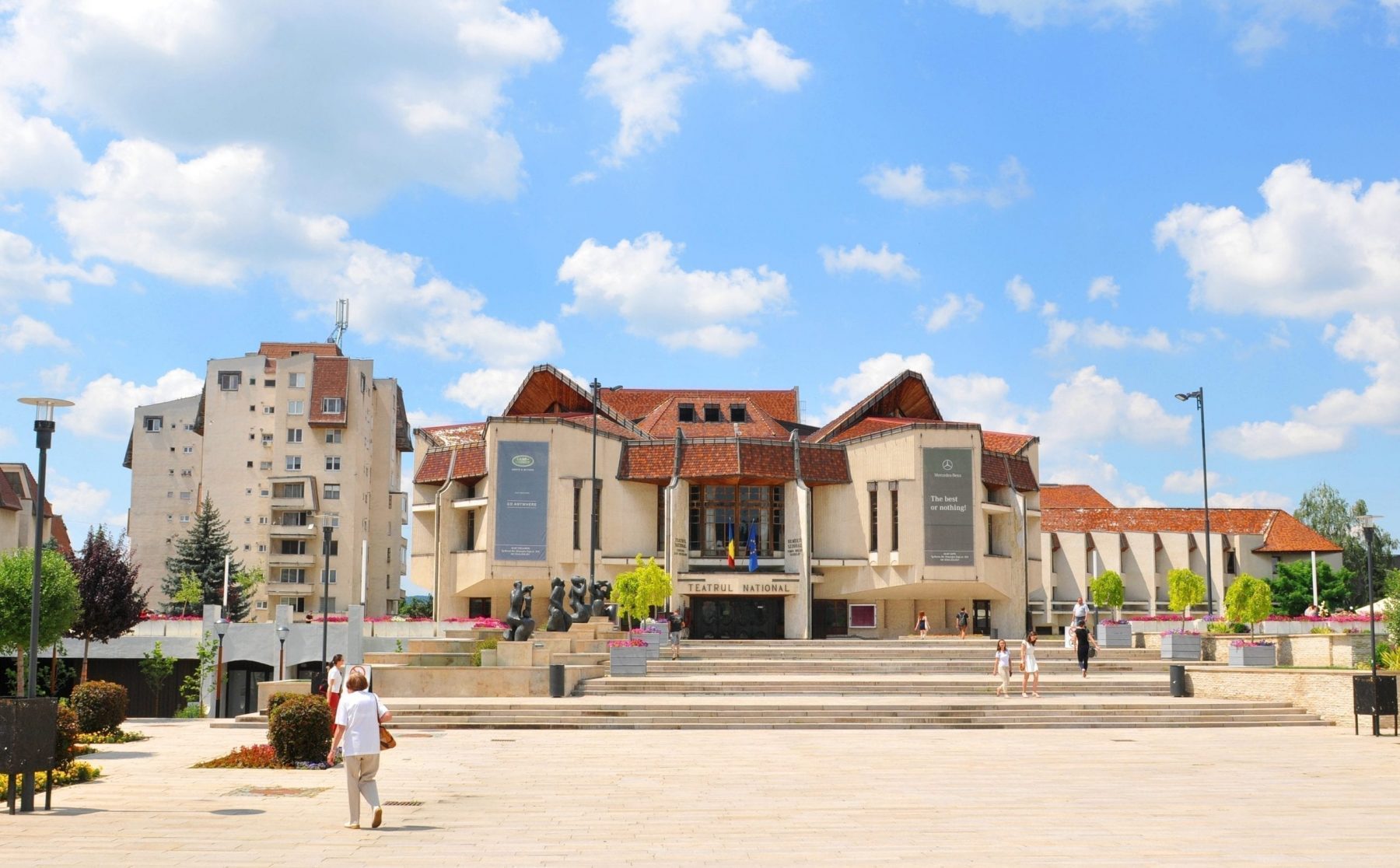
In 1965, at the 9th congress of the Romanian Communist Party, the decision was taken to establish three new state theatres: one in Bucharest, another in Craiova, and the third in Tîrgu Mureș. The construction of the edifice that you can now see, which started in 1971 and was completed two years later, represents the most significant architectural intervention by the communist regime in the city centre.
However, that shouldn’t lead us to believe that natives of Tîrgu Mureș hadn’t had the chance to attend the theatre before the inauguration of the current National Theatre. In 1946, right after the end of the Second World War, the Hungarian section of the State Theatre had been established. Performances took place in the Great Hall of the Palace of Culture. A decade and a half later, in 1962, the Romanian section was founded. The only place where they could stage theatre productions was, needless to say, the same Great Hall of the same Palace of Culture, which was starting to become rather crowded, as the Philharmonic State Orchestra also held concerts in the same location.
This demonstrates that the decision to construct a new building dedicated exclusively to theatre performances, despite being taken by an undemocratic body, wasn’t based on a whim.
Unfortunately, for the new building to be installed in its current position, a sacrifice had to be made, namely the demolition of all the buildings that previously stood here. The Franciscan Monastery complex, of which the baroque tower that you can now see in the corner of the square is all that remains.
The communist regime that was in power at the time was pleased with the results, and in 1973 the four architects who designed and coordinated the construction of the Tîrgu Mureș National Theatre were awarded a prize from the Romanian Union of Architects.
The modernist style of the building, which is characterised by angular shapes, its play on volume and its excess of corners, emanates a feeling of monumentality. At the entrance, the visitor is greeted by a spacious foyer, which takes up two levels that communicate with each other by means of two spiral staircases. The interior is richly decorated. The most frequently occurring materials are marble and wood. The walls are covered with carpets with vegetal motifs, while the space is punctuated in various places by huge items of furniture.
The most important feature is the main hall, with its 600 seats. There is also a second hall, which is smaller, and is used for experimental theatre performances and for smaller productions. The National Theatre building also contains space for offices for administrative staff, for dressing rooms and storage space for props.
As part of the same project, the area in front of the theatre was also remodelled. In one part of the square you can see an artesian well and a series of statues that depict the muses. Elsewhere you can see a work of art called the Shell, together with another group of statues that depict Genesis.
(From the special edition of TB 86 – „ENJOY TRANSYLVANIA!” – May/June 2019)


